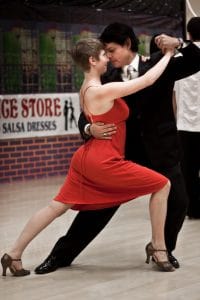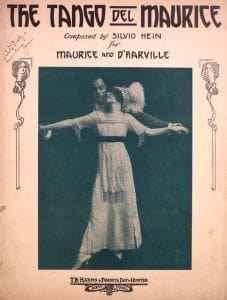December 11 marks International Tango Day in Argentina. It celebrates the dance and musical form. It is also the birth date of Carlos Gardel (December 11, 1890 - June 24, 1935), the French-Argentinian singer who was an international star as a musician and film actor in the early part of the 20th century. While he is most famous as a singer of tango songs, he also composed several of his own.
The Dance
The tango originated in the slums of Buenos Aires where it was created by the immigrants, primarily from Spain, Italy, and Germany, and recently freed African slaves who lived there in the late 19th century. Unmarried men made up much of this area's population, and when they weren't working on the city's docks they could be found in the bars and bordellos. It was there that the dance began, which contributed to its unsavory reputation in the early 20th century. The dance itself was a fusion of dances from the different cultures that lived there. Men often would partner with other men to practice the intricate steps of the dance, and in the bars and bordellos would dance with prostitutes.
Polite society "discovered" the tango in the early 20th century, and it was a popular dance in the 1910s and 1920s, though in some places it was still considered to be too risque. In 1913, a dance held in Pittsfield, Massachusetts, had a dance censor appointed by the town's mayor. The purpose of the censor was to keep an eye out for objectionable dances like the tango and the hesitation waltz. In Essex County, Massachusetts, the American Federation of Catholic Societies banned the dance from being danced in their halls. Here in Boston, Mayor Fitzgerald banned the tango along with the bunny hug, the turkey trot, and the bear dance from being danced in public dance halls of Boston. Meanwhile, that same year in London, professional tango dancers could earn up to $75,000 a year by teaching lessons and having public performances.
The Music
"Maurice Tango" as performed by pianist Peter Mintun, opens a new window
Perhaps the first piece of music that comes to mind when one thinks of the tango is "Jalousie" (aka "Jealousy"). It was written by the Danish composer Jacob Gade, and had its premiere in 1925 at the first showing of the movie Don Q Son of Zorro starring Douglas Fairbanks and Mary Astor. The tune has proved to be so popular that in the 1970s is was supposed that it was played on the radio once every minute somewhere in the world. There are many, many recordings of this piece, and you can listen to a recording of it from 1935 by following the link under "Streamed Audio Via Free Resources" below. If you're interested in hearing it as performed in 1990 by a klezmer band, follow the link under "Streamed Audio Via Library Resources" (for Boston Public Library card holders only).
The history of tango music cannot be written without a mention of Astor Piazzolla, born in Argentina in 1921. He is said to have revolutionized the genre in the 1950s with his Nuevo Tango (new tango), which incorporated non-traditional instruments like the electric guitar and saxophone. The music brought in elements of jazz and some classical techniques such as the fugue (example: his "Fugata for Bandoneon, Violin, Guitar, and Piano" from 1969), opens a new window. Piazzolla wrote his first tango in 1932 while his family was living in New York City. There, he also met Carlos Gardel and got a small role in one his movies. When he was 20 years old and once again living in Argentina, Piazzolla studied with the Argentinian composer Alberto Ginestera who taught him the art of orchestration. In the 1950s, he moved to Paris and studied with Nadia Boulanger where he honed his skills in counterpoint and classical compositions. She urged him to continue with tangos. Over the years he formed many different groups with different numbers of musicians and performed in concert halls around the world with them. He died in 1992.
CDs
Rough Guide to Tango Revival (Various Artists)
Diablo y Tango: Exotic Love Songs and Dances (Emil Altschuler, violin ; Aaron Larget-Caplan, guitar)
Songs from a heavy heart: essential tangos 1984-1989 (Astor Piazzolla)
Streamed Audio Via Library Resources [for Boston Public Library card holders]
Libertango: the Music of Astor Piazzolla (MacQuarie Trio)
Reunion: a Tango Excursion (Gary Burton and others)
Tango Argentino (Trio Pantango)
"Jalousie" (Brave Combo, from the album A Night On Earth)
Streamed Audio Via Free Resources
"Maurice Tango," banjo solo with orchestra (1912)
"Snobismo," piano, Bandoneón, and violin (1922)
Tango Argentina: Atilio Stampone & Orquesta Con Bando Neon (1958, from the Boston Public Library's vinyl LP collection)
Carlos Gardel: The Greatest Interpreter of Argentine Tangos, opens a new window (1942, from the Boston Public Library 78rpm collection)
"Jalousie; Tina" : Xavier Cugat & His Orchestra, opens a new window, (1935, from the Boston Public Library 78rpm collection)
Scores
Argentinean Tangos For Keyboard
Books
Dancing Tango: Passionate Encounters in a Globalizing World (Kathy Davis)
Tango: An Argentine Love Story (Camille Cusumano)
The Meaning of Tango: the Story of the Argentinian Dance (Christine Denniston)
Quickstart to Tango (Jeff Allen)
Tango! the Dance, the Song, the Story (Simon Collier and Ken Haas)
Streamed Film
Subtango, The Spirit of Tango. "This program presents four representations of the Argentine tango: tango canyengue, salon-style tango, tango milonguero, and tango fantasia. It explains the differences between Argentine tango and the ballroom tango and discusses tango star Carlos Gardel." [library resource for Boston Public Library card holders]
Tango "Set in Buenos Aires, Argentina, the film tells the story of director Mario Suarez's quest to make the ultimate tango film." [library resource for Boston Public Library card holders]
How to Dance Through Time, Vol. III: Dances of the Ragtime Era, 1910-1920 Fast forward to the 18:45 mark to see the tango danced as it was danced in the early part of the 20th century. [library resource for Boston Public Library card holders]
"18 Ultimate Tango", opens a new window, (2018, from MATV, Malden's Public Access TV) [freely available via archive.org]
Carlos Gardel, Historia de un Idolo, opens a new window (1964, in Spanish) [freely available via archive.org]




Add a comment to: World Tango Day